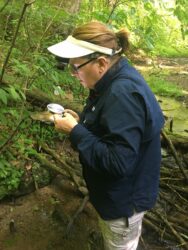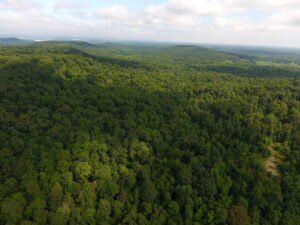By Andrew Berry
Bernheim researchers uncover Hidden Springsnail, known in only five other locations in the world

Bernheim Arboretum and Research Forest is calling the recent discovery of the Hidden Springsnail (Fontigens cryptica) further evidence a proposed Louisville Gas and Electric pipeline and a proposed Interstate 65-71 Regional Connector should not be constructed on Bernheim’s conservation land.
The Hidden Springsnail is a cave species that is translucent white and measures under two millimeters. It had not been documented from a living specimen for the past two decades until Bernheim researcher Lori Schroeder made the groundbreaking discovery.
Bernheim Director of Conservation Andrew Berry said the snail had only been discovered in five other places in the world and this is the first time it has been discovered in Kentucky.
Berry credited Benrheim’s pristine conservation land as an ideal location for it to live.

“Disrupting this healthy, intact forest with development could destroy not only the Hidden Springsnail’s habitat, but that of hundreds of plant and wildlife species that depend on this land for survival,” said Berry. “We are not opposed to development. We are opposed to projects that impact one of the last remaining wilderness tracts in central Kentucky. We are asking that alternate routes be used for these proposed projects.”
Just last month on the same tract of land, Bernheim announced the discovery of the Bluff Vertigo snail (Vertigo meramecensis) — another extremely rare snail known in fewer than 30 locations in the world.
Berry said both snails were found along the route of the proposed LG&E Pipeline and Interstate 65-71 Regional Connector. Their habitats are fragile and extremely susceptible to disturbance from the proposed projects that would include demolition and forest clearing.
The land is also home to other rare and threatened species, including federally endangered Indiana bats, northern long-eared bats and Kentucky glade cress.
“The cave systems, springs, streams, mature forests, knobs and rock outcroppings on which these species depend for survival would have to be cleared or disturbed to make way for the proposed projects,” Berry said.
Bernheim is requesting that LG&E and highway planners avoid all conservation lands as an option for these projects and any in the future. Berry added that the land through which the proposed LG&E pipeline would cut is protected by conservation easements and deed restrictions that prohibit destruction of natural resources or transfer of property for non-conservation purposes.

Bernheim’s executive director Dr. Mark Wourms, Ph.D. emphasized that even if those restrictions were not in place, Bernheim is committed to protecting the land.
“Bernheim is the largest privately held forest block dedicated to conservation and education in the eastern United States,” said Wourms. “For 90 years, we have been committed to conservation, preservation, education and research. Our management and board of trustees
are opposed to any development in this magnificent forest we protect.”
Wourms added that Bernheim contributes to the region’s economic vitality with more than 350,000 annual visitors as well as aiding in business and talent attraction.
“In addition to the wildlife habitat, Bernheim’s impact on human life cannot be understated as it provides clean air, clean water and unmatched beauty critical to the health and quality of life of all people in this region,” Wourms said. “It is a place where wildlife thrives and where people connect with nature. We want to keep it that way.”

